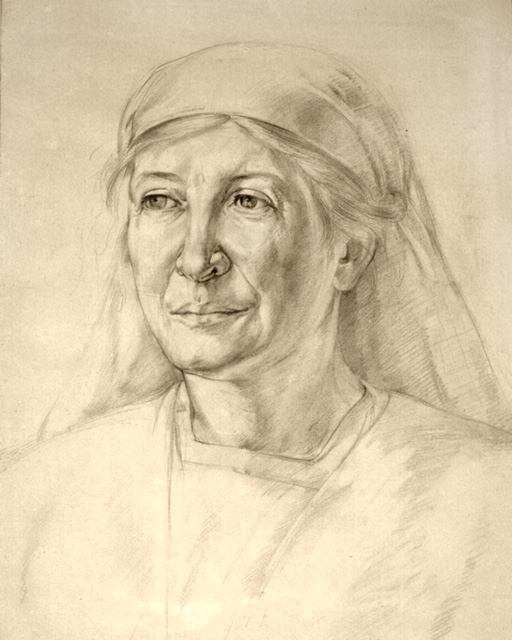Sometimes you can almost feel the history of a place. We're often aware of the White Ladies' enduring influence around Othona. Their ideals still have something to teach us. And their lifestyle has shaped our house and grounds.
Who were these White Ladies? A small community of women dedicated to a life of self-sufficiency and contemplative prayer. They had been part of a larger community founded by a remarkable woman called Adela Curtis – a writer, a spiritual teacher, a healer and a pioneer. (See pencil sketch of her below.)
At the turn of the century Miss Curtis had run a bookshop in West London and then her first venture into teaching meditation took place at her School of Silence, which was also based in Kensington. Her most ambitious project was the large community which she set up from 1914 in Cold Ash in Berkshire. This settlement flourished for a number of years but then ran into financial difficulties and eventually she had to sell. She thought her active life was over when she 'retired' to West Dorset and bought a 17 acre field overlooking Lyme Bay in 1921.
However, some of her followers insisted on following...! So instead of retirement she founded what became the Community of Christian Contemplatives. Most of her followers were women (Sisters) but some men also supported the work and took the title Brother.
The Sisters lived a very simple existence, each woman cultivating the land around a small timber cottage in which she lived. And they wove their own habits of un-dyed wool or cotton – before long the locals called them White Ladies. The house which is now Othona was their guest house and meeting place. Some visitors came from as far away as America (before the days of transatlantic flights). And in 1937 they raised enough money to add the chapel.
Miss Curtis must have been an unstoppable woman. She clearly inspired many people. She was writing books and pamphlets every morning. She gave two or three addresses in the chapel each week and held regular silent healing sessions. She wrote about prayer and theology and also about practical matters, such as the best way of building a compost heap! The writer Aldous Huxley spoke of her as Britain's one living mystic.
With the Second World War the main house was requisitioned by the army and the chapel became the storeroom for the furniture from the house. A few sisters carried on living in the outlying huts and persevered in praying and gardening until the war was over. But it had dealt their community a body blow. Some of the sisters died during this period also and although there continued to be some community life here into the 1950s, it was much diminished.
After Miss Curtis herself died at the age of 92 in 1960, the trustees of her charity started looking for a suitable organisation to which they could give the house and grounds, with a few of the sisters' cottages. Eventually their path crossed with that of Norman Motley and the Othona Community.
Liz Howlett, a resident member of the core team at Othona, has been researching Miss Curtis and her community.
- Her most recent blog posts have focussed on a research trip to the States in October 2023 and you can access them by clicking on this link.
- Liz also wrote a couple of blogs for the Dorset History Centre which you can see by clicking on the following links:

